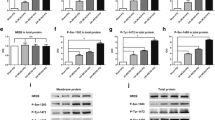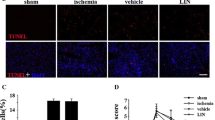Abstract
Our previous studies have showed that ginsenoside (GS)-Rd, a mono-compound isolated from traditional Chinese herb panax ginseng, has the neuroprotective effects following ischemic stroke. However, the underlying mechanisms are still largely unknown. Our latest study showed that GS-Rd could block calcium influx in cultured cortical neurons after excitotoxic injury, indicating that GS-Rd may act on cation channels. To explore this possibility, in this study, we used a rat middle cerebral artery occlusion (MCAO) model to examine the effects of GS-Rd on the expression of non-selective cation channels, including transient receptor potential melastatin (TRPM) and acid sensing ion channels (ASIC), and cation channels, including N-methyl-d-aspartate (NMDA) receptors, which all play essential roles in ischemic stroke. Our results showed that both TRPM and ASIC channels were expressed in the brain. At 24 h following MCAO insult, mRNA and protein expression levels of TRPM7, ASIC1a and ASIC2a were significantly increased. Pretreatment of 10 mg/kg GS-Rd attenuated MCAO-induced expression of TRPM7 and ASIC1a but promoted that of ASIC2a. In contrast, GS-Rd had no significant effects on the expression of NMDA receptors. Thus, our results suggest that GS-Rd neuroprotection following cerebral ischemia may be at least due to its effects on the expression of TRPM7, ASIC1a and ASIC2a.




Similar content being viewed by others
References
Yokozawa T, Dong E (2001) Role of ginsenoside-Rd in cisplatin-induced renal injury: special reference to DNA fragmentation. Nephron 89(4):433–438. doi:10.1159/000046116
Yokozawa T, Liu ZW, Dong E (1998) A study of ginsenoside-Rd in a renal ischemia-reperfusion model. Nephron 78(2):201–206. doi:10.1159/000044911
Yokozawa T, Satoh A, Cho EJ (2004) Ginsenoside-Rd attenuates oxidative damage related to aging in senescence-accelerated mice. J Pharm Pharmacol 56(1):107–113. doi:10.1211/0022357022449
Ye R, Han J, Kong X, Zhao L, Cao R, Rao Z, Zhao G (2008) Protective effects of ginsenoside Rd on PC12 cells against hydrogen peroxide. Biol Pharm Bull 31(10):1923–1927. doi:10.1248/bpb.31.1923
Ye R, Li N, Han J, Kong X, Cao R, Rao Z, Zhao G (2009) Neuroprotective effects of ginsenoside Rd against oxygen-glucose deprivation in cultured hippocampal neurons. Neurosci Res 64(3):306–310. doi:10.1016/j.neures.2009.03.016
Li N, Liu B, Dluzen DE, Jin Y (2007) Protective effects of ginsenoside Rg2 against glutamate-induced neurotoxicity in PC12 cells. J Ethnopharmacol 111(3):458–463. doi:10.1016/j.jep.2006.12.015
Wu J, Jeong HK, Bulin SE, Kwon SW, Park JH, Bezprozvanny I (2009) Ginsenosides protect striatal neurons in a cellular model of Huntington’s disease. J Neurosci Res 87(8):1904–1912. doi:10.1002/jnr.22017
Ye R, Zhang X, Kong X, Han J, Yang Q, Zhang Y, Chen Y, Li P, Liu J, Shi M, Xiong L, Zhao G (2011) Ginsenoside Rd attenuates mitochondrial dysfunction and sequential apoptosis after transient focal ischemia. Neuroscience 178:169–180. doi:10.1016/j.neuroscience.2011.01.007
Ye R, Yang Q, Kong X, Han J, Zhang X, Zhang Y, Li P, Liu J, Shi M, Xiong L, Zhao G (2011) Ginsenoside Rd attenuates early oxidative damage and sequential inflammatory response after transient focal ischemia in rats. Neurochem Int 58(3):391–398. doi:10.1016/j.neuint.2010.12.015
Liu X, Xia J, Wang L, Song Y, Yang J, Yan Y, Ren H, Zhao G (2009) Efficacy and safety of ginsenoside-Rd for acute ischaemic stroke: a randomized, double-blind, placebo-controlled, phase II multicenter trial. Eur J Neurol 16(5):569–575. doi:10.1111/j.1468-1331.2009.02534.x
Zhang C, Du F, Shi M, Ye R, Cheng H, Han J, Ma L, Cao R, Rao Z, Zhao G (2011) Ginsenoside Rd protects neurons against glutamate-induced excitotoxicity by inhibiting Ca(2+) influx. Cell Mol Neurobiol. doi:10.1007/s10571-011-9742-x
Davis SM, Albers GW, Diener HC, Lees KR, Norris J (1997) Termination of acute stroke studies involving selfotel treatment. Lancet 349(9044):32. doi:10.1016/S0140-6736(05)62166-6
Davis SM, Lees KR, Albers GW, Diener HC, Markabi S, Karlsson G, Norris J (2000) Selfotel in acute ischemic stroke: possible neurotoxic effects of an NMDA antagonist. Stroke 31(2):347–354. doi:10.1161/01.STR.31.2.347
Lees KR, Asplund K, Carolei A, Davis SM, Diener HC, Kaste M, Orgogozo JM, Whitehead J (2000) Glycine antagonist (gavestinel) in neuroprotection (GAIN International) in patients with acute stroke: a randomised controlled trial. Lancet 355(9219):1949–1954. doi:10.1016/S0140-6736(00)02326-6
Aarts M, Iihara K, Wei WL, Xiong ZG, Arundine M, Cerwinski W, MacDonald JF, Tymianski M (2003) A key role for TRPM7 channels in anoxic neuronal death. Cell 115(7):863–877. doi:10.1016/S0092-8674(03)01017-1
Sun HS, Jackson MF, Martin LJ, Jansen K, Teves L, Cui H, Kiyonaka S, Mori Y, Jones M, Forder JP, Golde TE, Orser BA, Macdonald JF, Tymianski M (2009) Suppression of hippocampal TRPM7 protein prevents delayed neuronal death in brain ischemia. Nat Neurosci 12(10):1300–1307. doi:10.1038/nn.2395
Fonfria E, Marshall IC, Benham CD, Boyfield I, Brown JD, Hill K, Hughes JP, Skaper SD, McNulty S (2004) TRPM2 channel opening in response to oxidative stress is dependent on activation of poly(ADP-ribose) polymerase. Br J Pharmacol 143(1):186–192. doi:10.1038/sj.bjp.0705914
Hara Y, Wakamori M, Ishii M, Maeno E, Nishida M, Yoshida T, Yamada H, Shimizu S, Mori E, Kudoh J, Shimizu N, Kurose H, Okada Y, Imoto K, Mori Y (2002) LTRPC2 Ca2+-permeable channel activated by changes in redox status confers susceptibility to cell death. Mol Cell 9(1):163–173. doi:10.1016/S1097-2765(01)00438-5
Xiong ZG, Chu XP, Simon RP (2006) Ca2+-permeable acid-sensing ion channels and ischemic brain injury. J Membr Biol 209(1):59–68. doi:10.1007/s00232-005-0840-x
Xiong ZG, Zhu XM, Chu XP, Minami M, Hey J, Wei WL, MacDonald JF, Wemmie JA, Price MP, Welsh MJ, Simon RP (2004) Neuroprotection in ischemia: blocking calcium-permeable acid-sensing ion channels. Cell 118(6):687–698. doi:10.1016/j.cell.2004.08.026
Johnson MB, Jin K, Minami M, Chen D, Simon RP (2001) Global ischemia induces expression of acid-sensing ion channel 2a in rat brain. J Cereb Blood Flow Metab 21(6):734–740. doi:10.1097/00004647-200106000-00011
Morin C, Zini R, Simon N, Tillement JP (2002) Dehydroepiandrosterone and alpha-estradiol limit the functional alterations of rat brain mitochondria submitted to different experimental stresses. Neuroscience 115(2):415–424. doi:10.1016/S0306-4522(02)00416-5
Sutherland BA, Shaw OM, Clarkson AN, Jackson DN, Sammut IA, Appleton I (2005) Neuroprotective effects of (−)-epigallocatechin gallate following hypoxia-ischemia-induced brain damage: novel mechanisms of action. FASEB J 19(2):258–260. doi:10.1096/fj.04-2806fje
Ye R, Kong X, Yang Q, Zhang Y, Han J, Li P, Xiong L, Zhao G (2011) Ginsenoside Rd in experimental stroke: superior neuroprotective efficacy with a wide therapeutic window. Neurotherapeutics 8(3):515–525. doi:10.1007/s13311-011-0051-3
Xiong ZG, Pignataro G, Li M, Chang SY, Simon RP (2008) Acid-sensing ion channels (ASICs) as pharmacological targets for neurodegenerative diseases. Curr Opin Pharmacol 8(1):25–32. doi:10.1016/j.coph.2007.09.001
Besancon E, Guo S, Lok J, Tymianski M, Lo EH (2008) Beyond NMDA and AMPA glutamate receptors: emerging mechanisms for ionic imbalance and cell death in stroke. Trends Pharmacol Sci 29(5):268–275. doi:10.1016/j.tips.2008.02.003
Simard JM, Tarasov KV, Gerzanich V (2007) Non-selective cation channels, transient receptor potential channels and ischemic stroke. Biochim Biophys Acta 1772(8):947–957. doi:10.1016/j.bbadis.2007.03.004
Jiang H, Tian SL, Zeng Y, Li LL, Shi J (2008) TrkA pathway(s) is involved in regulation of TRPM7 expression in hippocampal neurons subjected to ischemic-reperfusion and oxygen-glucose deprivation. Brain Res Bull 76(1–2):124–130. doi:10.1016/j.brainresbull.2008.01.013
Fonfria E, Murdock PR, Cusdin FS, Benham CD, Kelsell RE, McNulty S (2006) Tissue distribution profiles of the human TRPM cation channel family. J Recept Signal Transduct Res 26(3):159–178. doi:10.1080/10799890600637506
Fonfria E, Mattei C, Hill K, Brown JT, Randall A, Benham CD, Skaper SD, Campbell CA, Crook B, Murdock PR, Wilson JM, Maurio FP, Owen DE, Tilling PL, McNulty S (2006) TRPM2 is elevated in the tMCAO stroke model, transcriptionally regulated, and functionally expressed in C13 microglia. J Recept Signal Transduct Res 26(3):179–198. doi:10.1080/10799890600637522
Waldmann R, Champigny G, Bassilana F, Heurteaux C, Lazdunski M (1997) A proton-gated cation channel involved in acid-sensing. Nature 386(6621):173–177. doi:10.1038/386173a0
Shen L, Han JZ, Li C, Yue SJ, Liu Y, Qin XQ, Liu HJ, Luo ZQ (2007) Protective effect of ginsenoside Rg1 on glutamate-induced lung injury. Acta Pharmacol Sin 28(3):392–397. doi:10.1111/j.1745-7254.2007.00511.x
Kim S, Ahn K, Oh TH, Nah SY, Rhim H (2002) Inhibitory effect of ginsenosides on NMDA receptor-mediated signals in rat hippocampal neurons. Biochem Biophys Res Commun 296(2):247–254. doi:10.1016/S0006-291X(02)00870-7
Kim S, Kim T, Ahn K, Park WK, Nah SY, Rhim H (2004) Ginsenoside Rg3 antagonizes NMDA receptors through a glycine modulatory site in rat cultured hippocampal neurons. Biochem Biophys Res Commun 323(2):416–424. doi:10.1016/j.bbrc.2004.08.106
Lee E, Kim S, Chung KC, Choo MK, Kim DH, Nam G, Rhim H (2006) 20(S)-ginsenoside Rh2, a newly identified active ingredient of ginseng, inhibits NMDA receptors in cultured rat hippocampal neurons. Eur J Pharmacol 536(1–2):69–77. doi:10.1016/j.ejphar.2006.02.038
Acknowledgments
The authors are grateful to Ms. Dongyun Feng for technical assistance. This work was supported by grants from the National Natural Science Foundation of China (No. 31170801).
Conflict of interest
The authors declare that they have no conflict of interest.
Author information
Authors and Affiliations
Corresponding authors
Additional information
Y. Zhang and L. Zhou contributed equally to this work.
Rights and permissions
About this article
Cite this article
Zhang, Y., Zhou, L., Zhang, X. et al. Ginsenoside-Rd attenuates TRPM7 and ASIC1a but promotes ASIC2a expression in rats after focal cerebral ischemia. Neurol Sci 33, 1125–1131 (2012). https://doi.org/10.1007/s10072-011-0916-6
Received:
Accepted:
Published:
Issue Date:
DOI: https://doi.org/10.1007/s10072-011-0916-6




